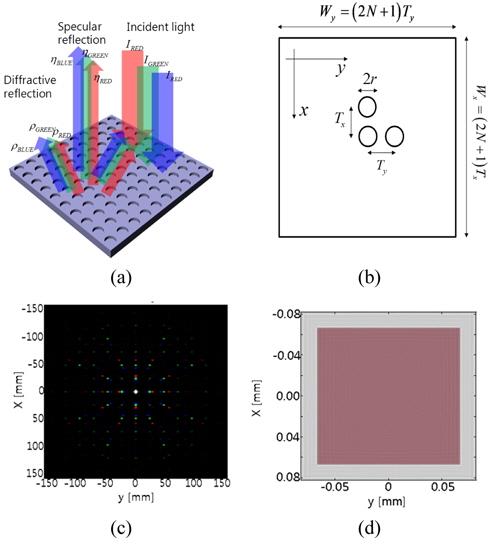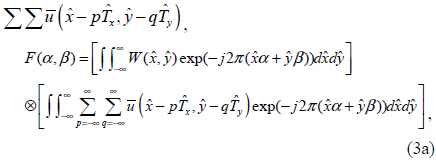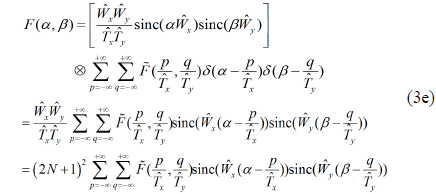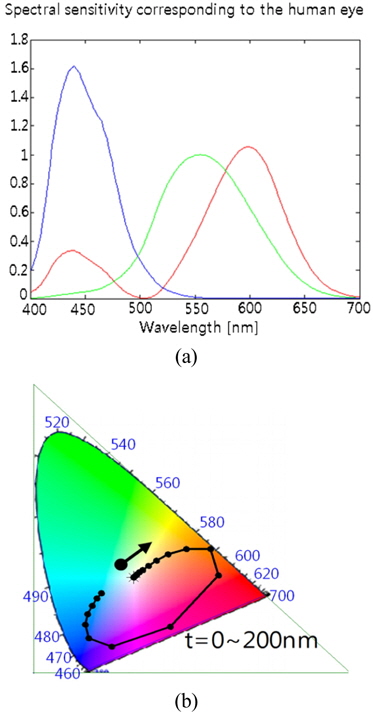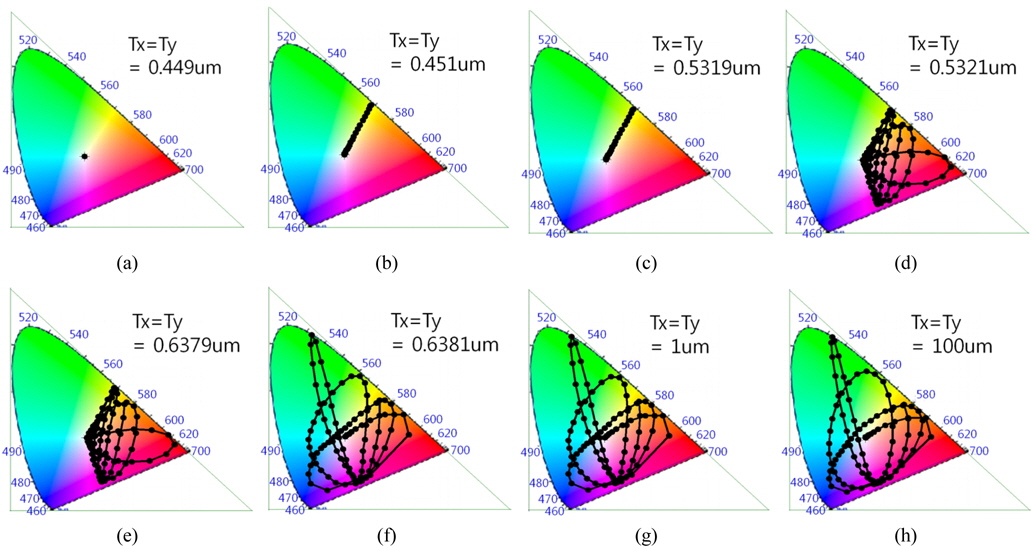



Specular structural colors generated by two-dimensional periodic binary gratings are investigated theoretically. An approximate mathematical model of the grating specular structural colors is described, based on scalar nonparaxial diffraction theory, and the functional relationships of specular structural color and structural parameters of gratings are analyzed. Through this, the optimal condition for maximizing the color-representation range in the standard CIE 1931 chromaticity diagram is derived.
Color is a fundamental constituent of culture and technology. Basic and applied research on coloring materials has been intensively conducted for a long time. Conventional coloring mechanisms originate inherently from the selective absorption and reflection of light by the coloring materials. In liquid crystal displays (LCDs), color filters are fabricated with absorptive pigments or dyes containing red, green, and blue color constituents [1]. In Denisyuk’s reflection color holography [2, 3], R(red, 638 nm), G (green, 532 nm), and B (blue, 450 nm) highly coherent lasers are illuminated on object surfaces, and the selective optical color-reflection waves on the object surfaces are recorded as the fringe patterns of refractive index in volume-hologram media. Interestingly, the resultant volume-hologram media produce full-color holographic images, based on a color-selective volume diffraction mechanism. The full-color volume holograms can be considered as excellent structural color media. Any periodic optical structures, such as classical diffraction gratings, show diffractive structure-dependent iridescent color patterns.
Recently, novel concepts and technologies in the field of nanophotonics have been applied to create new technologies for structural colors. Highly scalable and practical transmission color filters of subwavelength surface binary gratings, based on guided-mode resonance (GMR), were reported [4, 5]. Enhanced tunable color-filter devices were operated via active electro-optic control of surface-plasmon resonance (SPR) [6], but the intrinsic dissipative loss in metal decreases the transmission efficiency of SPR-based color filters and hinders their practicality [6-8]. Nonabsorbing structural representation color by means of superparamagnetic colloidal nanocrystal clusters, which is magnetically tunable and lithographically fixable, was also reported [9, 10], butits one-dimensional structure is known to exhibit iridescence.
The structural color generated by a diffraction grating has been understood as a diffractive chromatic dispersion effect, but has not been considered for exploitation in coloring applications, such as consumer product decoration, colorful artistic surface lettering, and color specular holography. In this paper we investigate the mechanism of the structural color appearing in the specular reflection on the surface of a binary diffraction grating, and its feasibility for applications. We introduce a theoretical model of the specular structural colors of binary diffraction gratings based on nonparaxial diffraction theory [11], and analyze the color-representation range of specular-reflection light in the standard CIE 1931 chromaticity diagram, to seek the optimal structural conditions to maximize the color-representation range.
This paper is organized as follows. In section 2, based on nonparaxial diffraction theory the mathematical modeling of specular structural color of a binary diffraction grating is depicted. In section 3, the color-representation range of the binary diffraction grating and the dependence of specular structural color on the structural parameters of gratings are analyzed on the standard CIE 1931 chromaticity diagram. Finally, concluding remarks are given.
II. MODELING OF SPECULAR STRUCTURAL COLORS OF BINARY DIFFRACTION GRATINGS
In this section the specular structural color of binary gratings is mathematically modeled. Figure 1(a) shows a schematic of the specular structural-color mechanism. A white plane wave is incident on a periodic binary grating, which is of reflection type and has a unit cell of circular intaglio with depth
In this paper, mainly the representation scope of the specular structural color of binary diffraction gratings is analyzed. To investigate this problem we develop a numerical model of specular structural color of a grating, based on nonparaxial scalar diffraction theory [11]. In scalar nonparaxial diffraction theory, the diffraction is supposed to be scalable with operating wavelength, which is seen in the use of the wavelength-normalized coordinate system in its theoretical framework. It is known that the fundamental quantity of nonparaxial diffraction is the renormalized diffracted radiance, defined as
where the coordinate pair (
where F represents a two-dimensional Fourier transform. Under the condition of the paraxial approximation, nonparaxial diffraction theory becomes equivalent to Fraunhofer diffraction theory in the far-field region around the optical axis. From a theoretical point of view, scalar nonparaxial diffraction theory can be considered as a relatively rough approximation of rigorous, vectorial electromagnetic diffraction theory. The scalar diffraction theory has limitations in explaining diffraction from subwavelength-scale features or polarization-sensitive structures. However, the diffraction from a two-dimensional periodic grating with circular unit pattern, as dealt with in this paper, is relatively immune to the polarization of the illumination light, and the iridescennt structural colors usually come from superwavelength-scale gratings, for which the scalar diffraction theory is appropriate. Therefore, nonparaxial scalar diffraction theory is appropriate for this study. Also, scalar diffraction theory is so efficient that it is useful for exploring the wide range of parameters studied in this paper.
The nonparaxial diffraction theory is applied to analyze the exemplary grating structure presented in Fig. 1(b). The complex optical-field distribution on the grating surface,
where is the optical-field distribution on the unit cell of the periodic grating and
where
In nonparaxial scalar diffraction theory, functions are usually described for spatial variables normalized by wavelength. Thus
where and are the wavelength-normalized terms
where ⊗ is the symbol for the convolution operator. The first integral term in Eq. (3a) is solved as
where sinc(
where is the angular spectrum of the optical field for a single unit cell,
Therefore, F(
In particular, when is equal to the grating includes only one unit element, so and Eq. (3e) reads equivalently as the Whittaker-Shannon interpolation formula of the band-limited signal,
More specifically, the specular structural colors of the exemplary circular intaglio grating schematically illustrated in Figs. 1(b) are analyzed. The optical field profile on a unit cell of the circular intaglio grating, , is represented by
where the exponential function e
The main task in the analysis of Eq. (3e) is to calculate the angular spectrum function of Substituting Eq. (4a) into Eq. (3d), we obtain as
where jinc(
As stated above, the structural color of a diffraction grating is perceived in the specular reflection, and is the zeroth-order diffracted radiance
where X, Y, and Z are the CIE XYZ tristimulus values for a color [12]. In particular, the tristimulus values for R, G, and B spectra are respectively defined as
where (
where
In the CIE 1931 chromaticity diagram, the standard white color has coordinates (
III. REPRESENTATION RANGE OF SPECULAR STRUCTURAL COLORS
Next the relationship between the specular structural colors and various structural parameters of binary diffraction gratings, such as grating period, fill factor, illumination angle, and grating depth, is investigated. The final objective of the analysis is to determine the represenation range of specular structural color in the CIE 1931 chromaticity diagram. The scope of the color representation lies inside the triangle defined by the three points indicating the wavelengths R (638 nm), G (532 nm), and B (450 nm) in the CIE 1931 diagram.
First, depth-dependent traces of the specular structural color are calculated on the chromaticity diagram for various grating periods. The depth-dependent traces with distinct features are selectively collected in Fig. 3, in descending order of the magnitude of the period. In simulations the fill factor is set to 0.4, and the incidence angle of white light is assumed to be normal to the surface of the grating. For a period of 449 nm (Fig. 3(a)), since the period is at subwavelength scale for all three wavelengths
An important note is that the color representation scope does not exactly reflect the diffraction efficiency of the grating, but it is determined by the relative ratio of the weighted R/G/B radiances. This problem has to be dealt with using numerical analysis, due to the complexity of the color-coordinate function. However, one insight is that the color representation scope tends to widen with increasing diffraction efficiency. From a simple analysis of Eqs. (7a)-(7c), we can see that the fill factor for maximum diffraction efficiency is 0.5. The condition for maximum color representation scope condition (fill factor 0.4) does not exactly match the condition for maximum diffraction (fill factor 0.5). The condition for maximum ratio maximum among R/G/B radiances can deviate from the condition for maximum diffraction efficiency. For example, a composite of maximally diffracted R/G/B components can produce a nearly white color, as proven in Fig. 4(d).
In practice, the illumination angle is considered as a variable, while the structural parameters are fixed. Thus the illumination has to be considered as an environmental variable, and the natural degree of freedom for observation of grating structural color. In Fig. 5 we analyze the change in the structural color, where the grating fill factor and period are set to 0.4 and
The specular structural colors generated by two-dimensional reflection-type periodic binary metallic gratings have been investigated, based on the scalar nonparaxial diffraction theory. The possible color-representation ranges for structural colors in the standard CIE 1931 chromaticity diagram, and the various structural dependences of the structural colors, have been analyzed. We have found that the range of structural color is not strongly dependent on the pattern period, when the period is greater than the red wavelength, and becomes maximized for a fill factor of 0.4. For practical coloring applications, such as artistic surface decoration of consumer products, or color specular holography, the structural color needs to be insensitive to the incidence angle of illumination, which requires further research on multilayered grating structures; in the near future we will design practical, multilayered structural color gratings based on what has been discussed in this paper.
